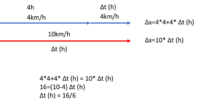I know the solution and how this problem is solved but don't know why it is done in that particular way, here is the question :
A walks at a uniform rate of 4
km an hour; and 4 hours after
his start, B bicycles after him at
the uniform rate of 10 km an
hour. How far from the starting
point will B catch A ?
The solution is to find the distance A travels in 4 hours , which is 4x4 km = 16 km, A has travelled 16km before B can start
Next the relative speed of A and B is obtained whichis 10-4 = 6 km per hour
I do not understand the next step, relative time = 16km / 6 kmph= 2.67 hr
and finally the B catches A at a distance of 10kmph x 2.67hr = 26.7 km from the starting point,
can anyone please explain this as I am unable to visualize it
Thank you
A walks at a uniform rate of 4
km an hour; and 4 hours after
his start, B bicycles after him at
the uniform rate of 10 km an
hour. How far from the starting
point will B catch A ?
The solution is to find the distance A travels in 4 hours , which is 4x4 km = 16 km, A has travelled 16km before B can start
Next the relative speed of A and B is obtained whichis 10-4 = 6 km per hour
I do not understand the next step, relative time = 16km / 6 kmph= 2.67 hr
and finally the B catches A at a distance of 10kmph x 2.67hr = 26.7 km from the starting point,
can anyone please explain this as I am unable to visualize it
Thank you

